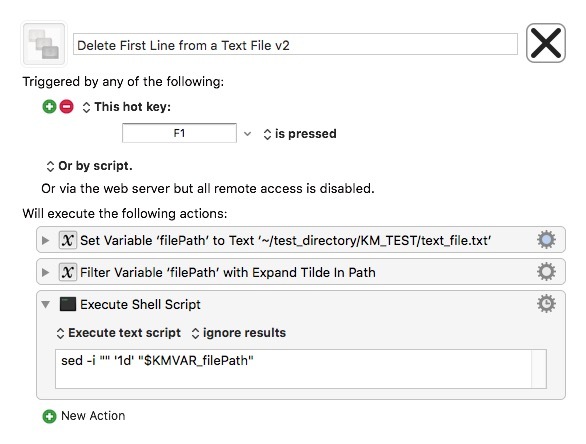

There’s no need for the user to be involved in any of this once the script is set up.Īnd as it turns out, automating interapplication communication and sidestepping user interaction is a godsend for malware authors. For example, you can have Mail.app automatically trigger a script when it receives an email from a certain sender, or with a particular keyword in the subject line or content, extract whatever details you want from the email, and then populate a database in Excel or Numbers with the desired information, formatted and sorted on-the-fly as the data comes in. So Why Do the Bad Guys Love Using AppleScript?ĪppleScript was designed for automation and interapplication communication: the goal being to allow ordinary users to chain together repetitive tasks and execute them without further user interaction. Indeed, AppleScript may have a good claim to being the Most Unloved and Unlovable Programming Language Ever.
#Applescript clean text mac
As a result, despite being with us for nearly 30 years, AppleScript is barely used by the majority of Mac admins, Mac developers or Mac end users. In short, the investment in time, effort and money required to produce something that still, after all that, can only be used on the macOS Desktop, effectively puts AppleScript at the bottom of the list for most people when it comes to choosing a useful or productive programming language. Until recently, the only 3rd party alternative to Script Editor was priced at $200 and had a time-limited, 20-day demo period.
#Applescript clean text code
There’s no debugger, there’s no variable introspection, there’s no code snippets or effective code completion, to name just a few missing features. Source: AppleScript Overview, © 2002, 2007 Apple Inc.Īnd it’s historically been difficult to develop scripts with AppleScript because most people who come to it will attempt to use the free, built-in but notoriously spartan (Apple)Script Editor.app, which lacks almost every and any feature developers normally expect and need. Set theFiles to name of every file of folder "bin" of folder "usr" of startup diskĪppleScript is also slow in execution because, among other things, the underlying technology involves constructing and sending Apple Events through an archaic interface called the Apple Event Manager that was written for Apple’s System 7 operating system (released in 1991) and not optimized for performance even back then. The AppleScript version, however, is something of an entirely different nature. Path, dirs, files = next(os.walk("/usr/bin")) Python is a little more verbose, but still fairly clean and familiar: #!/usr/bin/python As ever, a shell script will always be the most concise: ls -l /usr/bin | wc -l Compare the code for the simple task of counting the number of items in /usr/bin directory.

It’s quirky because it attempts to use “natural language” but in a grammar that is entirely artificial, often inconsistent and frustratingly unintuitive.
#Applescript clean text windows
Unlike Bash and other shell languages, and unlike Python, a cross-platform, beginner-friendly scripting language that has achieved widespread adoption and praise, AppleScript is a language peculiar to macOS not only can you NOT use it on other Desktop operating systems like Windows and Linux, you can’t even use it on Apple’s other operating systems like iOS and iPadOS.Īs a language, AppleScript has a reputation for being quirky, slow and difficult to develop even simple scripts with.

Why Have the Good Guys Ignored AppleScript? Worryingly, given the lack of attention paid to AppleScript in the research community, that is all without even leveraging some of AppleScript’s most powerful or unique features, some of which we’ll cover below (others I’ve written about before here). This includes its use in adware, its use for tasks such as persistence, anti-analysis, browser hijacking, spoofing and more. There is much less attention in the security field on AppleScript – a built-in macOS technology – despite the fact it’s been around for as long as Python and predates macOS 10 itself by 8 or 9 years.Īs I’ll show in this post, AppleScript is widely used by offensive actors. When we think about security on macOS and the tools used by offensive actors, whether those are real in the wild attacks or red team exercises, we tend to think of things like python scripts, shell scripts, malicious documents, shady extensions and of course, the fake, doctored or trojan application bundle.


 0 kommentar(er)
0 kommentar(er)
